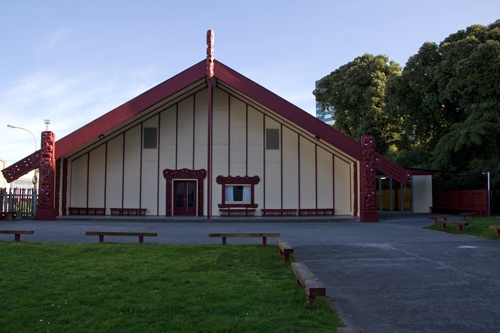
Pipitea Marae, Wellington (1980)
Urban Māori return
The Māori population more than doubled between 1961 and 1991, rising from 150,000 to 400,000. More significantly, it also urbanised. Pulled by job opportunities and government policies, Māori flooded into the cities and towns, accelerating a wartime phenomenon. Only 17% of Māori lived in urban areas in 1936; that figure was 26% by 1945, 62% by 1966 and 83% by 1986.
This brought the urban Pākehā population face to face with Māori for the first time in 100 years. Wellington had been the first township to ‘swamp’ Māori in the 1840s, even taking their minimal town reserves from them in exchange for rural ones. In colonial days ‘gradually the Māori disappeared from the streets of Wellington’. By the 1930s just a few hundred lived in the greater urban area and newcomers spoke feelingly about wandering the streets looking for the sight of another Māori face.
Twenty years after the ‘silent migration’ began, the first urban marae appeared in Auckland: Te Puea (1965), a traditional kin-based marae, but open to all; and the Catholic-run Te Ūnga Waka (1966). Another alternative emerged, the secular, multi-tribal marae, two examples being Arai Te Uru Marae in Kaikorai Valley, Dunedin (1979-80) and Pipitea Marae, opened on 31 May 1980 for what Ranginui Walker calls the ‘quasi-tribe’ Ngāti Poneke. Ngāti Poneke (a transliteration of Port Nicholson, the old name for Wellington) began as a city youth club in the 1930s and was encouraged by Sir Āpirana Ngata and Lady Pōmare.
The complex preserves the traditional relationship between the heavy concrete and steel building and open spaces, and there are wooden palisades, but a commercial car park beneath the building also brings in revenue. As relentlessly modern as its neighbours, the commercial towers of Thorndon Quay, the newly renovated Pipitea Marae continues to play its role in transplanting Māori culture into the urban milieu.
Further information
This site is item number 100 on the History of New Zealand in 100 Places list.
Websites
- Pipitea Marae
- Māori and the City - Te Ara
- Architecture Now article
Book
- Patricia Grace, Irihapeti Ramsden and Jonathan Dennis (eds), The silent migration, Huia, Wellington, 2001





Community contributions